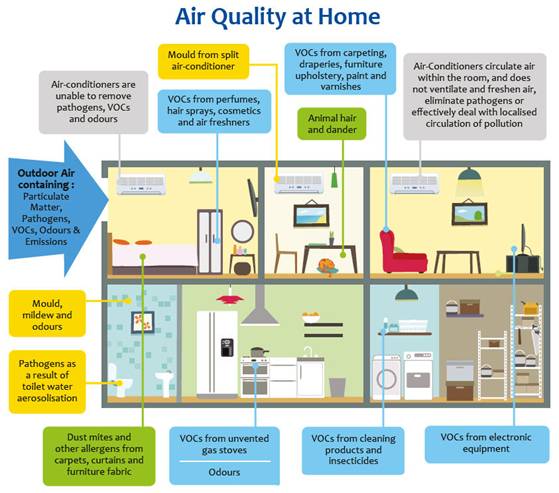Indoor air pollution can be a serious – and potentially deadly – problem. But a few simple tricks can reduce your risk, protect your health, and safeguard the health of your family.
What is indoor air pollution?
Gases or particles that are released into the air from a variety of sources can decrease the quality of our indoor air. This pollution can range from harmless to irritating to downright deadly.
Long-term exposure to polluted indoor air can increase your risk for respiratory diseases, heart disease, and even cancer. In fact, the US Environmental Protection Agency calls indoor air pollution one of the top 5 environmental health risks.
Where is this pollution coming from?
Indoor air pollution has many causes:
- Combustion sources – oil, gas, kerosene, coal and wood
- Tobacco products
- Asbestos
- Wet / damp carpet or building materials
- Cabinetry or furniture made of certain pressed wood products
- Household cleaning products
- Personal care products
- Radon
- Pesticides
- Outdoor air pollution
Some of these products, such as household cleaning products, release pollutants intermittently, only as long as you use them. Others, such as air fresheners, release pollutants continuously.
In addition, some of these products release gas pollutants, such as radon or formaldehyde, and some release fine particles such as asbestos or mold spores, that can be just as deadly.
Here are some major indoor air pollutants and their sources.
Radon: Comes from the ground beneath your home in addition to well water. It causes approximately 20,000 lung cancer deaths every year.
Tobacco smoke: You know where this one comes from: smoking. Tobacco smoke is the leading cause of lung cancer and it increases the risk of heart disease. It also contributes to developmental problems, lower respiratory tract infections, ear infections and more in children who are exposed.
Mold and mildew: Comes from wet or damp carpet, poorly maintained humidity levels, and wet sheetrock or other building materials. Molds and mildew can exacerbate asthma and allergies, and produce potentially toxic mycotoxins, otherwise known as fungus. Yuck.
Formaldehyde: Comes from pressed wood products such as plywood, wall paneling, and particleboard, as well as furniture made from these products. It can also come from combustion sources, tobacco smoke, textiles and glues. Formaldehyde can cause eye, nose and throat irritation, severe allergic reactions, and it’s a probable cause of cancer.
Fragrance: Comes from household cleaning products as well as personal care products. Artificial fragrance derives from a combination of almost 200 different chemicals that may or may not have been tested for safety and do not have to be individually listed. Fragrance can cause eye, nose and throat irritation, and often contains potentially cancer-causing chemicals.

How to measure your indoor air quality
Wondering if you have an air quality problem in your own home? There are several ways to find out.
- Test for radon levels. Radon is colorless and odorless, so there is no way to know without using a specific (and inexpensive) device to measure the levels in your home. These are available at home improvement stores or over the internet and cost about $10 to $30.
- If you have moisture condensation on windows or walls, stuffy air, or any mold or mildew you have a ventilation problem.
- For other concerns, or if you’re unsure, you can contact professionals who have experience in measuring and improving indoor air quality.
What can you do about it?
There are three main strategies to decrease air pollution in your home.
Remove the offender
Removing the offending source is usually best because it’s generally the most effective method.
For example, if you detect excessive radon levels in your home, setting up an appropriate radon mitigation system would be the best way to bring radon levels within acceptable limits. Same thing with removing moldy sheetrock or switching to unscented cleaning products.
Some of these fixes will be easy and inexpensive, while others might be more time-consuming or costly, but overall, removing the source is never a bad idea.
Improve ventilation
Improving ventilation can also drastically improve the air quality of your home. Opening windows and allowing the household air to exchange with air outdoors will decrease levels of many pollutants in your home, as indoor air levels are more concentrated. This is particularly important when you’re doing activities that can generate high levels of pollutants, such as painting or other home improvement projects, or even cooking.
Opening windows for at least 15 minutes every day will help to ensure better air quality and humidity levels in your home. Of course it’s not always possible to do this due to weather conditions.
Clean the air
Air cleaners, such as HEPA filters, can also be useful aids. It is important to note, however, that not all HEPA filters are created equal. Some are highly effective at removing particles, while others are not. Also, generally speaking, most filters are not designed to remove gas pollutants, only particles. So it’s important to consider the source of your home’s poor air quality before investing.
The effectiveness of a HEPA filter depends on its percentage efficiency rate. This is simply a measure of how well it collects pollutants from indoor air, and how much air it pulls into its filter.
Setting HEPA filters in the rooms where you spend the most time is a good way to improve the air quality of your home, as high-quality and appropriately sized filters can drastically decrease particle levels in your air.
Another, sometimes overlooked “filter” is the houseplant! True, the research on plants’ ability to decrease gas pollutants is limited. So far, their effectiveness has only been demonstrated in a lab and not a real-life home. (Incidentally, NASA did the testing.) But the indications are promising and it certainly won’t hurt to add a few beautiful plants to your décor.
In particular, plants such as broadleaf lady palm, lily turf, peace lily, spider plant, red-edged dracaena, and English Ivy may be helpful in removing gases like benzene, formaldehyde, trichloroethylene and ammonia.
Be aware, however, that some plants can be poisonous to cats, dogs, and children, so discuss this when purchasing and take care with their placement. If you’ve taken those simple precautions, adding plants to your home can help to clean its air.
Wrap-up
Indoor air pollution can be a serious and potentially deadly problem. But by taking a few simple steps you can reduce your risk and improve the quality of the air in your home.
- Test your home for radon in your air and water, and if necessary install an appropriate radon mitigation system.
- Use mostly unscented personal care and household cleaning items to decrease exposure to potentially irritating and harmful chemicals.
- Don’t smoke, especially indoors.
- Whenver possible, if purchasing pressed wood furniture and cabinetry (such as cribs, rocking chairs, dressers) ensure it has the GreenGuard symbol.
- Purchase a HEPA filter for your bedrooms, kitchen, home office and/or wherever you spend the most time in your home.
- Grow plants throughout your home to help remove dangerous gases.
- Maintain appropriate ventilation and humidity levels in your home. Use dehumidifiers and exhaust fans if necessary.
- Try to open several windows in your home for at least 15 minutes per day, weather permitting.
While you can’t make your air perfectly pure, you can take steps to improve your air quality and decrease exposure to potentially deadly pollutants.
However, don’t feel like you need to replace all the furniture in your home or all your household cleaning products. Simply do what you can easily do now, like increasing ventilation, purchasing some plants and a HEPA filer, or buying a dehumidifier for that damp basement.
Start with one small change, and then make smarter decisions in the future for your household and personal cleaning products, furniture, etc.
Perfection isn’t possible, but by making small changes over time, you can achieve big improvements.
Bonus
10Green.org is a cool website that allows you to see the air quality of the city you live in. While this relates to outdoor air quality, outdoor air quality will most certainly impact indoor air quality.
Environmental Working Group’s Skin Deep Cosmetics Database is an amazing resource to find out how your personal care products rate for health hazards. Over 75,000 products have been analyzed and given a score.
Environmental Working Group’s Cleaners Database is an new resource that will be available in the fall of 2012. It will provide the same kind of analysis as the cosmetics database, only focusing on household cleaning supplies.
How to Grow Fresh Air: 50 House Plants that Purify Your Home or Office by B. C. Wolverton is a book written by the NASA scientist who did the research on the ability of plants to improve air quality.
Eat, move, and live… better.©
Yep, we know… the health and fitness world can sometimes be a confusing place. But it doesn’t have to be.
Let us help you make sense of it all with this free special report.
In it you’ll learn the best eating, exercise, and lifestyle strategies – unique and personal – for you.
Click here to download the special report, for free.
References
Click here to view the information sources referenced in this article.





Share